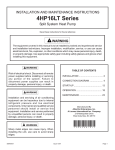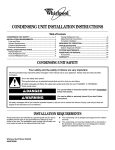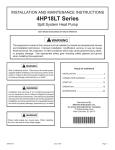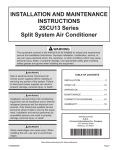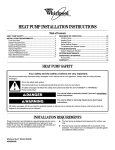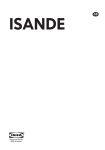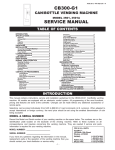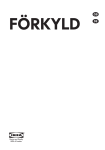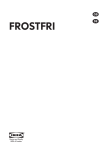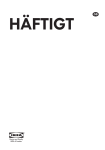Download Allied Air Enterprises 4AC16LT User's Manual
Transcript
INSTALLATION AND MAINTENANCE INSTRUCTIONS 4AC16LT SERIES Split System Air Conditioner Save these instructions for future reference WARNING The equipment covered in this manual is to be installed by trained and experienced service and installation technicians. Improper installation, modification, service, or use can cause electrical shock, fire, explosion, or other conditions which may cause personal injury, death, or property damage. Use appropriate safety gear including safety glasses and gloves when installing this equipment. WARNING TABLE OF CONTENTS Risk of electrical shock. Disconnect all remote power supplies before installing or servicing any portion of the system. Failure to disconnect power supplies can result in property damage, personal injury, or death. INSTALLATION .................................................... 2 START-UP .......................................................... 12 OPERATION ...................................................... 16 WARNING MAINTENANCE ................................................. 20 Installation and servicing of air conditioning equipment can be hazardous due to internal refrigerant pressure and live electrical components. Only trained and qualified service personnel should install or service this equipment. Installation and service performed by unqualified persons can result in property damage, personal injury, or death. CONNECTION DIAGRAM .................................. 22 Manufactured By Allied Air Enterprises, Inc. A Lennox International Inc. Company 215 Metropolitan Drive West Columbia, SC 29170 WARNING Sharp metal edges can cause injury. When installing the unit, use care to avoid sharp edges. 506467-01 *506467-01* Issue 1008 Page 1 INSTALLATION General Read this entire instruction manual, as well as the instructions supplied in separate equipment, before starting the installation. Observe and follow all warnings, cautions, instructional labels, and tags. Failure to comply with these instructions could result in an unsafe condition and/or premature component failure. These instructions are intended as a general guide only for use by qualified personnel and do not supersede any national or local codes in any way. The installation must comply with all provincial, state, and local codes as well as the National Electrical Code (U.S.) or Canadian Electrical Code (Canada). Compliance should be determined prior to installation. Inspection of Shipment Upon receipt of equipment, carefully inspect it for possible shipping damage. If damage is found, it should be noted on the carrier’s freight bill. Take special care to examine the unit inside the carton if the carton is damaged. Any concealed damage discovered should be reported to the last carrier immediately, preferably in writing, and should include a request for inspection by the carrier’s agent. If any damages are discovered and reported to the carrier DO NOT INSTALL THE UNIT, as claim may be denied. Check the unit rating plate to confirm specifications are as ordered. Location of Unit Refer to Figure 1 for installation clearances. Installation Clearances 4AC16LT condensing units use R410A which is an ozonefriendly HFC refrigerant. The unit must be installed with a matching indoor coil and line set. 4AC16LT units are designed for use in expansion valve (TXV) systems only. A filter drier approved for use with R410A is installed in the unit. 36” IMPORTANT: This product has been designed and manufactured to meet ENERGY STAR criteria for energy efficiency when matched with appropriate coil components. However, proper refrigerant charge and proper air flow are critical to achieve rated capacity and efficiency. Installation of this product should follow the manufacturer’s refrigerant charging and air flow instructions. Failure to confirm proper charge and airflow may reduce energy efficiency and shorten equipment life. 36” * 36” 36” * * A service clearance of 30" must be maintained on one of the sides adjacent to the control box. Clearance to one of the other three sides must be 36". Clearance to one of the remaining two sides may be 12" and the final side may be 6". When servicing or repairing HVAC components, ensure the fasteners are appropriately tightened. Table 1 shows torque values for fasteners. A clearance of 24" must be maintained between units. 48" clearance required on top of unit. Maximum soffit overhang is 36". Torque Table Figure 1 Fastener Torque Stem Caps 8 ft. lbs. Service Port Caps 8 ft. lbs. Sheet Metal Screws 16 in. lbs. #8 Machine Screws 16 in. lbs. #10 Machine Screws 28 in. lbs. Compressor Bolts 90 in. lbs. Slab Mounting When installing a unit at grade level, install on slab high enough above grade so that water from higher ground will not collect around the unit (See Figure 2). Roof Mounting Install unit at a minimum of 4” above surface of the roof. Care must be taken to ensure weight of unit is properly distributed over roof joists and rafters. Either redwood or steel supports are recommended. Table 1 506467-01 Issue 1008 Page 2 Thermostat Designations Slab Mounting Discharge Air Building Structure Mounting Slab See unit wiring diagram for power supply connections. If the indoor unit is not equipped with a blower relay, one must be field supplied and installed. Ground Level Figure 2 Do not connect C (common) connection between indoor unit and thermostat except when required by the indoor thermostat. Refer to thermostat installation instructions. C (common) connection between indoor unit and outdoor unit required for proper operation. Electrical Wiring All field wiring must be done in accordance with the National Electrical Code (NEC) recommendations, Canadian Electrical Code (CEC) and CSA Standards, or local codes, where applicable. Figure 4 5. Do not bundle any excess 24V control wire inside control box. Run control wire through installed wire tie and tighten wire tie to provide low voltage strain relief and to maintain seperation of field-installed low and high voltage circuits. WARNING Unit must be grounded in accordance with national and local codes. Failure to ground unit properly can result in personal injury or death. Refrigerant Piping WARNING Refer to the furnace or blower coil installation instructions for additional wiring application diagrams and refer to unit rating plate for minimum circuit ampacity and maximum overcurrent protection size. Refrigerand can be harmful if inhaled. Refrigerant must always be used and recovered responsibly. Incorrect or irresponsible use of refrigerant can result in personal injury or death. 1. Install line voltage power supply to unit from a properly sized disconnect switch. Any excess high voltage field wiring should be trimmed or secured away from the low voltage field wiring. If the 4AC16LT unit is being installed with a new indoor coil and line set, the refrigerant connections should be made as outlined in this section. If an existing line set and/or indoor coil will be used to complete the system, refer to this section as well as the section that follows entitled - Flushing Existing Line Set and Indoor Coil. 2. Ground unit at unit disconnect switch or to an earth ground. To facilitate conduit, a hole is in the bottom of the control box. Connect conduit to the control box using a proper conduit fitting. Units are approved for use only with copper conductors. 24V Class II circuit connections are made in the low voltage junction box. A complete unit wiring diagram is located inside the unit control box cover (see also page 22 of this instruction). 3. Install room thermostat on an inside wall that is not subject to drafts, direct sunshine, or other heat sources. 4. Install low voltage wiring from outdoor to indoor unit and from thermostat to indoor unit (See Figure 3). 506467-01 If this unit is being matched with an approved line set or indoor coil which was previously charged with R-22 refrigerant, the line set and coil must be flushed prior to installation. If the unit is being used with and existing indoor coil which was equipped with a liquid line which served as a metering device (RFCI), the liquid line must be replaced prior to the installation of the 4AC16LT unit. Field refrigerant piping consists of liquid and suction lines from the outdoor unit (sweat connections) to the indoor coil (flare or sweat connections). Issue 1008 Page 3 Select line set diameters from Table 2 to ensure that oil return to the compressor. Size vertical suction riser to maintain minimum velocity at minimum capacity. Recommended line length is 50’ or less. If more than 50’ line set is required, contact Technical Service. WARNING Polyolester (POE) oils used with R-410A refrigerant absorb moisture very quickly. It is very important that the refrigerant system be kept closed as much as possible. DO NOT remove line set caps or service valve stub caps until ready to make connections. Table 2 shows the diameters for line sets up to 100’ although vertical lift applications and trapping requirements need to be reviewed with Technical Service for line sets over 50’. Refrigerant Line Set Diameters (in.) L iquid L ine B T UH L ine S e t L e ngth a nd S iz e 12 ft. 25 ft. 50 ft. 75 ft. 100 ft. 24,000 3/8 3/8 3/8 3/8 3/8 36,000 3/8 3/8 3/8 3/8 1/2 48,000 3/8 3/8 3/8 1/2 1/2 60,000 3/8 3/8 3/8 1/2 1/2 S uction L ine L ine S e t L e ngth a nd S iz e B T UH 12 ft. 25 ft. 50 ft. 75 ft. 100 ft. 24,000 3/4 3/4 3/4 3/4 7/8 36,000 7/8 7/8 7/8 7/8 1-1/8 48,000 7/8 1-1/8 1-1/8 1-1/8 1-1/8 60,000 1-1/8 1-1/8 1-1/8 1-1/8 1-1/8 For installations exceeding 50’, contact Technical Services. Table 2 Installing Refrigerant Line During the installation of an air conditioning system, it is important to properly isolate the refrigerant line to prevent unnecssary vibration. Line set contact with the structure (wall, ceiling, or floor) may cause objectionable noise when vibration is translated into sound. As a result, more energy or vibration can be expected. Close attention to line set isolation must be observed. If refrigeration lines are routed through a wall, seal and isolate the opening so vibration is not transmitted to the building. Following are some points to consider when placing and installing a high-efficiency outdoor unit: Placement Be aware that some localities are adopting sound ordinances based on how noisy the unit is at the neighbor’s home, not at the original installation. Install the unit as far as possible from the property line. When possible, do not install the unit directly outside a bedroom window. Glass has a verry high level of sound transmission. Figure 4 shows how to place the outdoor unit and line set to reduce line set vibration. Line Set Isolation Illustrations on the pages 6 and 7 demonstrate procedures which ensure proper refrigerant line set isolation. Figure 6 shows how to install line sets on horizontal runs. Figure 7 shows how to make a transition from horizontal to vertical. Figure 9 shows how to install line sets on vertical runs. Brazing Connection Procedure 1. Cut ends of refrigerant lines square (free from nicks or dents). Debur the ends. The pipe must remain round; do not pinch end of line. 2. Before making line set connections, use dry nitrogen to purge the refrigerant piping. This will help to prevent oxidation and the introduction of moisture into the system. 3. Use silver alloy brazing rods (5% or 6% silver alloy for copper-to-copper brazing or 45% silver alloy for 506467-01 Issue 1008 Page 4 copper-to-brass or copper-to-steel brazing) which are rated for use with R410A refrigerant. Outside Unit Placement and Installation 4. Remove the Schrader core assemblies before brazing to protect them from damage due to extreme heat. Replace the cores when brazing is complete. Install unit away from windows 5. Remove light maroon washers from service valves and shield light maroon stickers to protect them during brazing. Wrap a wet cloth around the valve body and copper tube stub to protect it from heat damage. 6. Braze the line set to the service valve. Quench the joints with water or a wet cloth to prevent heat damage to the valve core and opening port. The tube end must stay bottomed in the fitting during final assembly to ensure proper seating, sealing, and rigidity. 7. Install a thermal expansion valve (which is sold separately and which is approved for use with R410A refrigerant) in the liquid line at the indoor coil (see Refrigerant Metering Device on page 8). Two 90° elbows installed in lineset will reduce lineset vibration Figure 4 Refrigerant Line Sets: Installing Horizontal Runs To hang line set from joist or rafter, use either metal strapping material or anchored heavy nylon wire ties. Wire Tie (around vapor line only) 8’ Strapping Material (around vapor line only) Floor Joist or Roof Rafter Tape or Wire Tie 8’ Strap the vapor line to the joist or rafter at 8’ intervals then strap the liquid line to the vapor line. Metal Sleeve Floor Joist or Roof Rafter Tape or Wire Tie Figure 5 506467-01 Issue 1008 Page 5 Refrigerant Line Sets: Transition from Vertical to Horizontal Automotive Muffler-Type Hanger Anchored Heavy Nylon Wire Tie Strap Liquid Line to Vapor Line Wall Stud Strap Liquid Line to Vapor Line Wall Stud Liquid Line Metal Sleeve Liquid Line Vapor Line – Wrapped in Armaflex Metal Sleeve Vapor Line – Wrapped in Armaflex Figure 6 Refrigerant Line Sets: Installing Vertical Runs (new construction shown) IMPORTANT: Refrigerant lines must not contact wall. NOTE: Similar installation practices should be used if line set is to be installed on exterior of outside wall. Outside Wall Vapor Line Liquid Line Wood Block Between Studs Wire Tie Inside Wall Strap Sleeve Vapor Line Wrapped with Armaflex Wire Tie Liquid Line IMPORTANT: Refrigerant lines must not contact structure. Outside Wall Wood Block Wire Tie Strap Caulk PVC Pipe Fiberglass Insulation 506467-01 Figure 7 Issue 1008 Sleeve Page 6 Flushing Existing Line Set and Indoor Coil Flushing Procedure This procedure should not be performed on systems which contain contaminants, such as compressor burn out. IMPORTANT: The line set and/or indoor coil must be flushed with at least the same amount of refrigerant that previously charged the system. Check the charge in the flushing cylinder before flushing the unit. CAUTION When flushing existing line set and/or indoor coil, be sure to empty all existing traps. Residual mineral oil can act as an insulator, preventing proper heat transfer. It can also clog the thermal expansion valve, reducing system performance and capacity. Failure to properly flush system as explained in these instructions will void warranty. 1. Remove existing R22 refrigerant using the appropriate procedure. Required Equipment The following equipment is needed to flush the existing line set and indoor coil (see Figure 8): Two clean R22 recovery bottles, an oil-less recovery machine with a “pump down” feature, and two sets of gauges (one for use with R22 and one for use with R410A). If the existing outdoor unit is not equipped with shutoff valves, or if the unit is not operational AND the existing R22 refrigerant will be used to flush the system: Disconnect all power to the existing outdoor unit. Connect the existing unit, a clean recovery cylinder, and the recovery machine according to the instructions provided with the recovery machine. Remove all R22 refrigerant from the existing system. Refer to the gauges after shutdown to confirm that the entire system is completely void of refrigerant. Disconnect the liquid and suction lines from the existing outdoor unit. If the existing outdoor unit is equipped with manual shutoff valves AND new R22 refrigerant will be used to flush the system: Start the existing R22 refrigerant system in cooling mode and close the liquid line valve. Pump all the existing R22 refrigerant back into the outdoor unit. Flushing Connections Note: The inverted R22 cylinder must contain at least the same amount of refrigerant as was recovered from the existing system. Figure 8 506467-01 Issue 1008 Page 7 (It may be necessary to bypass the low pressure switches to ensure complete refrigerant evacuation.) When the low side system pressures reach 0 psig, close the suction line valve. Disconnect all power to the existing outdoor unit. Refer to the gauges after shutdown to confirm that the valves are not allowing refrigerant to flow back into the low side of the system. Disconnect the liquid and suction lines from the existing outdoor unit. 2. Remove the existing outdoor unit. Set the new R410A unit and follow the brazing connection procedure outlined previously on this page to make line set connections. Do not install the R410A thermal expansion valve at this time. 3. Make low voltage and line voltage connections to the new outdoor unit. Do not turn on power to the unit or open the outdoor unit service valves at this time. 9. Close the valve on the inverted R-22 cylinder and the gauge set valves. Pump the remaining refrigerant out of the recovery machine and turn the machine off. 10. Use nitrogen to break the vacuum on the refrigerant lines and indoor coil before removing the recovery machine, gauges, and R-22 refrigerant drum. Re-install pressure tap valve cores into the 4AC16LT unit’s service valves. 11. Install the refrigerant expansion valve approved for use with R410A refrigerant in the liquid line at the indoor coil. Refrigerant Metering Device 4AC16LT units are designed for use with TXV systems only. Expansion valves equipped with Chatleff-type fittings are available from the manufacturer. See Table 3 for proper TXV for each unit. TXV Data 4. Remover the existing R-22 refrigerant flow control orifice or thermal expansion valve before continuing with flushing procedures. R-22 flow control devices are not approved for use with R410A refrigerant and may prevent proper flushing. Use a field-provided fitting to reconnect the lines. MODEL 5. Remove the pressure tap valve cores from the 4AC16LT units service valves. Connect an R-22 cylinder with clean refrigerant to the suction service valve. Connect the R-22 gauge set to the liquid line valve and connect a recovery maching with an empty recovery tank to the gauge set. PART NUMBER 4AC16LT -24, -36 A4TXV01 4AC16LT -48 A4TXV02 4AC16LT -60 A4TXV02 Table 3 To install an expansion valve (See Figure 9 above): 6. Set the recovery machine for liquid recovery and start the recovery machine. Open the gauge set valves to allow the recovery machine to pull a vacuum on the existing system line set and indoor coil. 7. Invert the cylinder of clean R-22 and open its valve to allow liquid refrigerant to flow in to the system through the suction line valve. Allow the refrigerant to pass from the cylinder and through the line set and the indoor coil before it enters the recovery machine. 8. After all of the liquid refrigerant has been recovered, switch the recovery machine to vapor recovery so that all of the R22 vapor is recovered. Allow the recovery machine to pull a vacuum on the sytem. NOTE: A single system flush should remove all of the mineral oil from the existing refrigerant lines and indoor coil. A second flushing may be done (using clean refrigerant) if insufficient amounts of mineral oil were removed during the first flush. After each system flush, allow the recovery machine to pull a vacuum on the system at the end of the procedure. 506467-01 1. Separate the distributor assembly and remove the piston orifice and used teflon seal. Insert nozzle end of the expansion valve along with a new teflon seal into the distributor and tighten to 20 - 30 ft. lbs. Use backup wrench on all wrench flats. Overtightening will crush the teflon seal and may cause a leak. 2. Attach liquid line portion of distributor assembly along with new teflon seal to the inlet of the expansion valve. Tighten to 20 - 30 ft. lbs. Use backup wrench on all wrench flats. Overtightening will crush the teflon seal and may cause a leak. 3. Connect the external equalizer line to the equalizer port on the suction line and tighten to 8 ft.lbs. 4. Strap the superheat sensing bulb to the suction header. If installing an expansion valve on an indoor coil that previously used a fixed orifice, be sure to remove the existing fixed orifice. Failure to remove a fixed orifice when installing an expansion valve to the indoor coil will result in improper operation and damage to the system. Issue 1008 Page 8 Figure 9 Manifold Gauge Set Manifold guage sets used with systems charged with R410A refrigerant must be capable of handling the higher system operating pressures. The gauges should be rated for use with pressures 1 - 800 on the high side and a low side of 30” vacuum to 250 psi with dampened speed to 500 psi. Gauge hoses must be rated for use at up to 800 psi of pressure with a 4000 psi burst rating. Liquid and Suction Line Service Valves The liquid line and suction line service valves (See Figure 11) and service ports are used for leak teating, evacuation, charging, and checking charge. Each valve is equipped with a service port which has a factory-installed Schrader valve. A service port cap protects the Schrader valve from contamination and serves as the primary leak seal. To Access the Schrader Port: 1. Remove the service port cap with an adjustable wrench. Figure 10 To Close Liquid or Suction Line Service Valve: 1. Remove the stem cap with an adjustable wrench. 2. Connect gauge to the service port. 2. Use a service wrench with a hex-head extension to turn the stem clockwise to seat the valve. Tighten firmly. 3. When testing is completed, replace service port cap. Tighten finger tight, then an additional 1/6 turn. 3. Replace the stem cap. Tighten finger tight, then tighten an additional 1/6 turn. To Open Liquid or Suction Line Service Valve: Remove stem cap with an adjustable wrench. Use service wrench with a hex-head extension to back the stem out counterclockwise as far as it will go. Use a 3/16” hex head extension for liquid line service valves and a 5/16” extension for suction line service valves. Replace the stem cap. Tighten finger tight, then tighten an additional 1/6 turn. 506467-01 Suction Line (Ball Type) Service Valve Suction line (ball type) service valves function the same way as the other valves; the difference is in the construction. The ball valve is equipped with a service port with a factoryinstalled Schrader valve. A service port cap protects the Schrader valve from contamination and serves as the primary seal. Issue 1008 Page 9 2. With both manifold valves closed, connect the cylinder of R410A refrigerant. Open the valve on the R410A cylinder (vapor only). Ball Type Service Valve (Valve Open) 3. Open the high pressure side of the manifold to allow R410A into the line set and indoor unit. Weigh in a trace amount of R410A. (A trace amount is a maximum of 2 oz. of refrigerant or 3 lbs. pressure.) Close the valve on the R410A cylinder and the valve on the high pressure side of the manifold gauge set. Disconnect the R410A cylinder. 4. Connect a cylinder of nitrogen with a pressure regulating valve to the center port of the manifold gauge set. When using high pressure gas such as nitrogen for this purpose, be sure to use a regulator that can control the pressure down to 1 or 2 psig. 5. Adjust nitrogen pressure to 150 psig. Open the valve on the high side of the manifold gauge set to pressurize the line set and the indoor coil. Use adjustable wrench. To open, rotate stem counterclockwise 1/4 turn (90°). To close, rotate stem clockwise 1/4 turn (90°). 6. After a short period of time, open a refrigerant port to make sure that an adequate amount of refrigerant has been added for detection (refrigerant requirements will vary with lengths). Check all joints for leaks. Purge nitrogen and R410A mixture. Correct any leaks and recheck. Figure 11 Leak Testing After the line set has been connected to the indoor and outdoor units, the line set connections and indoor unit must be checked for leaks. Evacuation Evacuating the system of noncondensables is critical for proper operation of the unit. Noncondensables are defined as any gas that will not condense under temperatures and pressures present during operation of an air conditioning system. Noncondensables and water vapor combine with refrigerant to produce substances that corrode copper piping and compressor parts. WARNING Fire, Explosion, and Personal Safety Hazard. Failure to follow this warning could result in damage, personal injury, or death. WARNING Never use oxygen to pressurize or purge refrigeration lines. Oxygen, when exposed to a spark or open flame, can cause damage by fire and/or an explosion, that could result in personal injury or death. Do not use a compressor to evacuate a system. Avoid deep vacuum operation. Extremely low vacuums can cause internal arcing and compressor failure. Danger of equipment damage. Damage caused by deep vacuum operation will void warranty. Using an Electronic Leak Detector 1. Connect the high pressure hose of the manifold gauge set to the suction valve service port. (Normally the high pressure hose is connected to the liquid line port; however, connecting it to the suction ports helps to protect the manifold gauge set from damage caused by high pressure.) Use a thermocouple or thermistor electronic vacuum gauge that is calibrated in microns. Use an instrument that reads down to 50 microns. 1. Connect the manifold gauge set to the service valve ports as follows: • • 506467-01 Issue 1008 Low pressure gauge to suction line service valve High pressure gauge to liquid line service valve Page 10 of 22 of 222. Connect micron gauge. 3. Connect the vacuum pump (with vacuum gauge) to the center port of the manifold gauge set. 4. Open both manifold valves and start vacuum pump. 5. Evacuate the line set and indoor unit to a minimum of 500 microns or lower. During the early stages of evacuation, it is desirable to close the manifold gauge valve at least once to determine if there is a rapid rise in pressure. A rapid rise in pressure indicates a relatively large leak. If this occurs, the leak testing procedure must be repeated. 6. When 500 microns or lower is maintained, close the manifold gauge valves, turn off the vacuum pump, and disconnect the manifold gauge center port hose from the vacuum pump. Attach the manifold gauge center port hose to a nitrogen cylinder with pressure regulator set to 150 psig and purge the hose. Open the manifold gauge valves to break the vacuum in the line set and indoor unit. Close the manifold gauge valves. 7. Shut off the nitrogen cylinder and remove the manifold gauge hose from the cylinder. Open the manifold gauge valves to release the nitrogen from the line set and indoor unit. 8. Reconnect the manifold gauge to the vacuum pump, turn the pump on, and continue to evacuate the line set and indoor unit until 500 microns is maintained within a 20-minute period after shutting off the vacuum pump and closing the manifold gauge valves. 9. When the requirements above have been met, disconnect the manifold hose from the vacuum pump. Open the service valves to break the vacuum in the line set and indoor unit. 506467-01 Issue 1008 Page 11 START-UP Refrigerant Charge Adjustment CAUTION If unit is equipped with a crankcase heater, it should be energized 24 hours before unit start-up to prevent compressor damage as a result of slugging. Liquid Line Set Diameter Oz. per 5 ft. adjust from 15 ft. line set* 3/8 in. 3 oz. per 5 ft. * If line length is greater than 15 ft., add this amount. If line length is less than 15 ft., remove this amount. 1. Rotate fan to check for frozen bearings or binding. Table 4 2. Inspect all factory and field-installed wiring for loose connections. IMPORTANT 3. After evacuation is complete, open liquid line and suction line service valves to release refrigerant charge (contained in outdoor unit) into system. Mineral oils are not compatible with R410A. If oil must be added, it must be a polyol ester oil. 4. Replace the stem caps and secure finger tight, then tighten an additional 1/6 of a turn. If the system is void of refrigerant, clean the system using the procedure described below. 5. Check voltage supply at the disconnect switch. The voltage must be within the range listed on the unit nameplate. If not, do not start equipment until the power company has been consulted and the voltage condition corrected. 1. Use dry nitrogen to pressurize the system and check for leaks. Repair leaks, if possible. 2. Evacuate the system to remove as much of the moisture as possible. 6. Set thermostat for cooling demand, turn on power to indoor blower and close the outdoor unit disconnect switch to start the unit. 3. Use dry nitrogen to break the vacuum. 4. Evacuate the system again. 7. Recheck unit voltage with unit running. Power must be within range shown on unit nameplate. 5. Weigh the appropriate amount of R410A refrigerant (listed on unit nameplate) into the system. Refrigerant Charging This system is charged with R410A refrigerant which operates at much higher pressures than R22. The liquid line drier provided with the unit is approved for use with R410A. Do not replace it with one designed for use with R22. This unit is NOT approved for use with coils which use capillary tubes as a refrigerant metering device. R410A refrigerant cylinders are rose colored. Refrigerant should be added through the vapor valve in the liquid state. Certain R410A cylinders are identified as being equipped with a dip tube. These allow liquid refrigerant to be drawn from the bottom of the cylinder without inverting the cylinder. Do not turn this type of cylinder upside down to draw refrigerant. 6. Monitor the system to determine the amount of moisture remaining in the oil. Use a test kit to verify that the moisture content is within the kit’s dry color range. It may be necessary to replace the filter drier several times to achieve the required dryness level. If system dryness is not verified, the compressor will fail in the future. The outdoor unit should be charged during warm weather. However, applications arise in which charging must occur in the colder months. The method of charging is determined by the outdoor ambient temperature. Measure the liquid line temperature and the outdoor ambient temperature as outlined below: 1. Connect the manifold gauge set to the service valve ports as follows: Units are factory charged with the amount of R410A refrigerant indicated on the unit rating plate. This charge is based on a matching indoor coil and outdoor coil with 15' line set. For varying lengths of line set, refer to Table 4 for refrigerant charge adjustment. 506467-01 Issue 1008 • • Low pressure gauge to suction line service valve High pressure gauge to liquid line service valve Page 12 2. Close manifold gauge set valves. Connect the center manifold hose to an upright cylinder of R410A. Blocking Outdoor Coil Outdoor coil should be blocked one side at a time with cardboard or plastic sheet until proper testing pressures are reached. 3. If room temperature is below 70°F, set the room thermostat to call for heat. This will create the necessary load for properly charging the system in the cooling cycle. 4. Use a digital thermometer to record the outdoor ambient temperature. Cardboard or Plastic Sheet 5. When the heating demand has been satisfied, switch the thermostat to cooling mode with a set point of 68°F. When pressures have stabilized, use a digital thermometer to record the liquid and suction line temperatures. 6. The outdoor temperature will determine which charging method to use. Proceed with the appropriate charging method. Figure 12 4. Subtract the liquid line temperature from the saturation temperature (according to the chart) to determine subcooling. _____ ° Saturation Temperature °F Charge Using Weigh-In Method – _____ ° Liquid Line Temperature °F If the system is void of refrigerant, or if the outdoor ambient temperature is cool, first locate and repair any leaks then use the weigh-in method to charge the unit. = _____ ° Subcooling Value °F 1. Recover the refrigerant from the unit. 2. Conduct a leak check, then evacuate as previously outlined. 3. Weigh in the charge according to the total amount shown on the unit nameplate. 5. Compare the subcooling value with those shown in Table 6 on page 14. If subcooling is greater than shown, recover some refrigerant. If subcooling is less than shown, add some refrigerant. Charge Using Approach Method – Outdoor Temperatures 65°F or Above If weighing facilities are not available, use one of the following procedures to charge the unit. The following procedure is intended as a general guide and is for use on expansion valve systems only. For best results, indoor temperature should 70°F to 80°F. Monitor system pressures while charging. Charge Using Subcooling Method – Outdoor Temperatures Below 65°F 1. Record outdoor ambient temperature using a digital thermometer. When the outdoor ambient temperature is below 65°F, the subcooling method can be used to charge the unit. It may be necessary to restrict the air flow through the outdoor coil to achieve pressures in the 200-250 psig range. These higher pressures are necessary for checking the charge. Block equal sections of air intake panels and move obstructions sideways until the liquid pressure is in the 200-250 psig range (see Figure 12). 2. Attach high pressure gauge set and operate unit for several minutes to allow system pressures to stabilize. 1. With the manifold gauge hose on the liquid service port and the unit operating stably, use a digital thermometer to record the liquid line temperature. 3. Compare stabilized pressures with those provided in Table 8 on page 15. Minor variations in these pressures may be expected due to differences in installations. Significant differences could mean that the system is not properly charged or that a problem exists with some component in the system. Pressures higher than those listed indicate that the system is overcharged. Pressures lower than those listed indicate that the system is undercharged. Verify adjusted charge using the approach method. 2. At the same time, record the liquid line pressure reading. 3. Use the temperature/pressure chart (Table 5 on page 14) to determine the saturation temperature for the liquid line pressure reading. 506467-01 Issue 1008 4. Use the same digital thermometer to check liquid line temperature. 5. Subtract the outdoor ambient temperature from the liquid line temperature to determine the approach temperature. Page 13 Subcooling Values R410A Temperature/Pressure Chart Temp. (F P re s s u re P s ig Temp. (F P re s s u re P s ig Temp. (F P re s s u re P s ig 32 1 0 0 .8 74 2 1 4 .0 116 3 9 6 .0 33 1 0 2 .9 75 2 1 7 .4 117 4 0 1 .3 34 1 0 5 .0 76 2 2 0 .9 118 4 0 6 .7 35 1 0 7 .1 77 2 2 4 .4 119 4 1 2 .2 36 1 0 9 .2 78 2 2 8 .0 120 4 1 7 .7 37 1 1 1 .4 79 2 3 1 .6 121 4 2 3 .2 38 1 1 3 .6 80 2 3 5 .3 122 4 2 8 .8 39 1 1 5 .8 81 2 3 9 .0 123 4 3 4 .5 40 1 1 8 .0 82 2 4 2 .7 124 4 4 0 .2 41 1 2 0 .3 83 2 4 6 .5 125 4 4 5 .9 42 1 2 2 .6 84 2 5 0 .3 126 4 5 1 .8 43 1 2 5 .0 85 2 5 4 .1 127 4 5 7 .6 44 1 2 7 .3 86 2 5 8 .0 128 4 6 3 .5 45 1 2 9 .7 87 2 6 2 .0 129 4 6 9 .5 46 1 3 2 .2 88 2 6 6 .0 130 4 7 5 .6 47 1 3 4 .6 89 2 7 0 .0 131 4 8 1 .6 48 1 3 7 .1 90 2 7 4 .1 132 4 8 7 .8 49 1 3 9 .6 91 2 7 8 .2 133 4 9 4 .0 50 1 4 2 .2 92 2 8 2 .3 134 5 0 0 .2 51 1 4 4 .8 93 2 8 6 .5 135 5 0 6 .5 52 1 4 7 .4 94 2 9 0 .3 136 5 1 2 .9 53 1 5 0 .1 95 2 9 5 .1 137 5 1 9 .3 54 1 5 2 .8 96 2 9 9 .4 138 5 2 5 .8 55 1 5 5 .5 97 3 0 3 .8 139 5 3 2 .4 56 1 5 8 .2 98 3 0 8 .2 140 5 3 9 .0 57 1 6 1 .0 99 3 1 2 .7 141 5 4 5 .6 58 1 6 3 .9 100 3 1 7 .2 142 5 5 2 .3 59 1 6 6 .7 101 3 2 1 .8 143 5 5 9 .1 60 1 6 9 .6 102 3 2 6 .4 144 5 6 5 .9 61 1 7 2 .6 103 3 3 1 .0 145 5 7 2 .8 62 1 7 5 .5 104 3 3 5 .7 146 5 7 9 .8 63 1 7 8 .5 105 3 4 0 .5 147 5 8 6 .8 64 1 8 1 .6 106 3 4 5 .3 148 5 9 3 .8 65 1 8 4 .3 107 3 5 0 .1 149 6 0 1 .0 66 1 8 7 .7 108 3 5 5 .0 150 6 0 8 .1 67 1 9 0 .9 109 3 6 0 .0 151 6 1 5 .4 68 1 9 4 .1 110 3 6 5 .0 152 6 2 2 .7 69 1 9 7 .3 111 3 7 0 .0 153 6 3 0 .1 70 2 0 0 .6 112 3 7 5 .1 154 6 3 7 .5 71 2 0 3 .9 113 3 8 0 .2 155 6 4 5 .0 72 2 0 7 .2 114 3 8 5 .4 73 2 1 0 .6 115 3 9 0 .7 72 2 0 7 .2 114 3 8 5 .4 73 2 1 0 .6 115 3 9 0 .7 Table 6 ° Liquid Line Temperature °F _ ° Outdoor Ambient Temperature °F = ° Approach Temperature °F 6. Compare the approach value with those shown in Table 7. If the values do not agree with those provided in Table 7, add refrigerant to lower the approach temperature or recover refrigerant from the system to increase the approach temperature. Check Charge Using Normal Operating Pressures Use Table 8 to perform maintenance checks. Table 8 is not a procedure for charging the system. Minor variations in these pressures may be due to differences in installations. Significant deviations could mean that the system is not properly charged or that a problem exists with some component in the system. Approach Values for TXV Systems Approach value is the liquid line temperature minus the outdoor ambient temperature (± 1°F). Note: For best results, use the same digital thermometer to check both outdoor ambient and liquid temperatures. Table 7 Table 5 506467-01 Issue 1008 Page 14 Normal Operating Pressures L = Liquid S = Suction Values provided above are typical pressures. Indoor unit matchup, indoor air quality, and indoor load will cause pressures to vary. Table 8 506467-01 Issue 1008 Page 15 OPERATION Outdoor unit and indoor blower cycle on demand from the room thermostat. When the thermostat blower switch is moved to the ON position, the indoor blower operates continuously. System Diagnostic Module 4AC16LT units contain a diagnostic module for troubleshooting air conditioning system failures. By monitoring and analyzing data from the compressor and thermostat demand, the module can accurately detect the cause of electrical and system related failure without any sensors. If a system problem occurs, a flashing LED indicator communicates the failure code. LED Description POWER LED (Green) indicates voltage is present at the power connection of the module. Thermostat Demand Wiring The diagnostic module requires a thermostat demand signal to operate properly. The thermostat demand signal input, labeled Y on the module, should always be connected to the compressor contactor coil so that when the coil is energized, the demand signal input is 24VAC. When the coil is not energized, the demand signal input should be less than 0.5VAC. Miswired Module Codes Depending on the system configuration, some ALERT flash codes may not be active. The presence of safety switches affects how the system alerts are displayed by the module. Miswiring the diagnostic module will cause false LED codes. Table 11 on page 19 describes LED operation when the module is miswired and what troubleshooting action is required to correct the problem. ALERT LED (Yellow) communicates an abnormal system condition through a unique flash code. The ALERT LED will flash a number of times consecutively, pause, and then repeat the process. The number of consecutive flashes correlates to a particular abnormal condition. TRIP LED (Red) indicates there is a demand signal from the thermostat but no current to the compressor is detected by the module. The TRIP LED typically indicates the compressor protector is open or may indicate missing supply power to the compressor. Interpreting the Diagnostic LEDs When an abnormal system condition occurs, the diagnostic module displays the appropriate ALERT and/or TRIP LED. The yellow ALERT LED will flash a number of times consecutively, pause, and then repeat the process. To identify a flash code number, count the number of consecutive flashes. Refer to Table 9 on page 17 and Table 10 on page 18 for information on the flash codes. Every time the module powers up, the last ALERT LED flash code that occurred prior to shutdown is displayed for 60 seconds. The module will continue to display the previous flash code until the condition returns to normal or 24VAC is removed from the module. TRIP and ALERT LEDs flashing at the same time means control circuit voltage is too low for operation. 24VAC Power Wiring The diagnostic module requires a constant nominal 24VAC power supply. The wiring to the module’s R and C terminals must be directly from the indoor unit or thermostat. 506467-01 Issue 1008 Page 16 Flash Codes LED Status Fault Description POWER (Green) Module has power TRIP (Red) ALERT (Yellow) Flash Code 1 ALERT (Yellow) Flash Code 2 Thermostat demand signal Y1 is present, but the compressor is not running Troubleshooting Information Supply voltage is present at module terminals 1. Compressor protector is open * Check for high head pressure * Check compressor supply voltage 2. Outdoor unit power disconnect is open 3. Compressor circuit breaker or fuse(s) is open 4. Broken wire or connector is not making contact 5. Low pressure switch open if present in system 6. Compressor contactor has failed open Long Run Time Compressor is running extremely long run cycles 1. Low refrigerant charge 2. Evaporator blower is not running * Check blower relay coil and contacts * Check blower motor capacitor * Check blower motor for failure or blockage * Check evaporator blower wiring and connector * Check indoor blower control board * Check thermostat wiring for open circuit 3. Evaporator coil is frozen * Check for low suction pressure * Check for excessively low thermostat setting * Check evaporator airflow (coil blockages or return air filter) * Check ductwork or registers for blockage 4. Faulty metering device * Check TXV bulb installation (size, location, and contact) * Check if TXV/fixed orifice is stuck closed or defective 5. Condenser coil is dir ty 6. Liquid line restriction (filter drier blocked if present in system) 7. Thermostat is malfunctioning * Check thermostat sub-base or wiring for shor t circuit * Check thermostat installation (location, level) System Pressure Trip Discharge or suction pressure out of limits or compressor overloaded 1. High head pressure * Check high pressure switch if present in system * Check if system is overcharged with refrigerant * Check for non-condensable in system 2. Condenser coil poor air circulation (dirty, blocked, damaged) 3. Condenser fan is not running * Check fan capacitor * Check fan wiring and connectors * Check fan motor for failure or blockage 4. Return air duct has substantial leakage 5. If low pressure switch present in system, check Flash Code 1 info Table 9 506467-01 Issue 1008 Page 17 Flash Codes (cont.) LED Status Fault Description ALERT (Yellow) Flash Code 3 Short Cycling Compressor is running only briefly 1. Thermostat demand signal is intermittent 2. Time delay relay or control board defective 3. If high pressure switch present, go to Flash Code 2 info 4. If low pressure switch present, go to Flash Code 1 info Locked Rotor 1. Run capacitor has failed 2. Low line voltage (contact utility if voltage at disconnect is low) * Check wiring connections 3. Excessive liquid refrigerant in compressor 4. Compressor bearings are seized *Measure compressor oil level ALERT (Yellow) Flash Code 5 Open Circuit 1. Outdoor unit power disconnect is open 2. Compressor circuit breaker or fuse(s) is open 3. Compressor contactor has failed open * Check compressor contactor wiring and connectors * Check for compressor contactor failure (burned, pitted, or open) * Check wiring and connectors between supply and compressor * Check for low pilot voltage at compressor contactor coil 4. High pressure switch is open and requires manual reset 5. Open circuit in compressor supply wiring or connections 6. Unusually long compressor protector reset time due to extreme ambient temperature 7. Compressor windings are damaged * Check compressor motor winding resistance ALERT (Yellow) Flash Code 6 Open Start Circuit Current only in run circuit 1. Run capacitor has failed 2. Open circuit in compressor star t wiring or connections * Check wiring and connectors between supply and the compressor S terminal 3. Compressor star t winding is damaged * Check compressor motor winding resistance ALERT (Yellow) Flash Code 7 Open Run Circuit Current only in star t circuit 1. Open circuit in compressor run wiring or connections * Check wiring and connectors between supply and the compressor R terminal 2. Compressor run winding is damaged * Check compressor motor winding resistance ALERT (Yellow) Flash Code 8 Welded Contactor Compressor always runs 1. Compressor contactor has failed closed 2. Thermostat demand signal not connected to module ALERT (Yellow) Flash Code 9 Low Voltage Control circuit less than 17VAC ALERT (Yellow) Flash Code 4 Troubleshooting Information 1. Control circuit transformer is overloaded 2. Low line voltage (contact utility if voltage at disconnect is low) * Check wiring conditions Table 10 506467-01 Issue 1008 Page 18 Miswired Module Troubleshooting Miswired Module Indication Recommended Troubleshooting Action Green LED is not on, module does not power up. Determine if both R and C module terminals are connected. Verify voltage is present at module's R and C terminals. Review 24VAC Power Wiring section on page 16 for R and C wiring. Green LED intermittent, module powers up only when compressor runs. Determine if R and Y terminals are wired in reverse. Verify module's R and C terminals have a constant source. Review 24VAC Power Wiring section on page 16 for R and C wiring. TRIP LED is on but system and compressor check OK. Verify Y terminal is connected to 24VAC at contactor coil. Verify voltage at contactor coils falls below 0.5VAC when off. TRIP LED and ALERT LED flashing together. Verify R and C terminals are supplied with 19-28VAC. ALERT Flash Code 3 (Compressor Shor t Cycling) displayed incorrectly. Verify Y terminal is connected to 24VAC at contactor coil. Verify voltage at contactor coil falls below 0.5VAC when off. ALERT Flash Code 5, 6, or 7 (Open Circuit, Open Star t Circuit, or Open Run Circuit) displayed incorrectly. Check that compressor run and star t wires are through module's current sensing holes. Verify Y terminal is connected to 24VAC at contactor coil. Verify voltage at contactor coil falls below 0.5VAC when off. ALERT Flash Code 6 (Open Start Circuit) displayed for Code 7 (Open Run Circuit or vice versa. Check that compressor run and star t wires are routed through correct module sensing holes. ALERT Flash Code 8 (Welded Contactor) displayed incorrectly. Determine if module's Y terminal is connected. Verify Y terminal is connected to 24VAC at contactor coil. Verify 24VAC is present across Y and C when thermostat demand signal is present. If not, R and C are reverse wired. Verify voltage at contactor coil falls below 0.5VAC when off. Review Thermostat Demand Wiring on page 16 for Y and C wiring. Table 11 506467-01 Issue 1008 Page 19 MAINTENANCE 4. Check all wiring for loose connections. 5. Check for correct voltage at unit (with unit operating). WARNING Before performing maintenance operations on system, turn the electric power to unit OFF at disconnect switch(es). Unit may have multiple power supplies. Electrical shock could cause personal injury or death. 6. Check amp-draw on blower motor. Unit nameplate _________ Actual _________ Maintenance and service must be performed by a qualified installer or service agency. At the beginning of each cooling season, the system should be checked as follows: 1. Clean and inspect condenser coil. Coil may be flushed with a water hose. Be sure the power is off before using water to clean the coil. 2. Outdoor fan motor is pre-lubricated and sealed. No further lubrication is needed. 3. Visually inspect connecting lines and coils for evidence of oil leaks. 4. Check wiring for loose connections. 5. Check for correct voltage at unit (with unit operating). 6. Check amp-draw outdoor fan motor. Unit nameplate _________ Actual _________ NOTE – If owner complains of insufficient cooling, the unit should be gauged and refrigerant charge checked. Refer to the Refrigerant Charging section on page 12. Indoor Coil 1. Clean coil, if necessary. 2. Check connecting lines and coils for evidence of oil leaks. 3. Check condensate pan line and clean, if necessary. Indoor Unit 1. Clean or change filters. 2. Adjust blower speed for cooling. Measure the pressure drop over the coil to determine the correct blower CFM. 3. Belt drive blowers: Check belt for wear and proper tension. 506467-01 Issue 1008 Page 20 Start-Up and Performance Checklist Job Name _______________________________ Job No. ________________ Date ______________ Job Location _____________________________ City ___________________ State ______________ Installer _________________________________ City ___________________ State ______________ Unit Model No. ______________ Serial No. ___________________ Service Technician ________________________________________ Nameplate Voltage ______________ Rated Load Ampacity ________ Outdoor Fan ___________________ Compressor _______________ Maximum Fuse or Circuit Breaker ________________________ Electrical Connections Tight? Indoor Filter Clean? Indoor Blower RPM _____________ S.P. Drop Over Indoor (Dry) ____________ Outdoor Coil Entering Air Temperature _____________ Discharge Pressure ___________ Refrigerant Charge Checked? Thermostat: Calibrated? 506467-01 Voltage with Compressor Operating _____________ Vapor Pressure ____________ Outdoor Fan Checked? Refrigerant Lines: Leak Checked? Service Valves: Fully Opened? Supply Voltage (Unit Off) ________________ Properly Insulated? Caps Tight? Properly Set? Level? Issue 1008 Page 21 LT BLUE OUTDOOR FAN DUAL CAPACITOR PURPLE BLACK F R RED Y2 YELLOW C BLACK Y1 YELLOW COMPRESSOR CRANKCASE HEATER (IF USED) R RED BLUE R C L S TO 24 VAC POWER SOURCE 20 VA MINIMUM NEC CLASS 2 H C Y1 Y2 COMPRESSOR CONTACTOR RED ORANGE C L2 L1 208-230/60/1 GROUND LUG GROUND B1 C 1 BLACK L1 S R S4 HIGH PRESSURE A132 L Y2 R Y1 C SWITCH K1-1 208-230/60/1 S24 LOSS OF CHARGE SWITCH YELLOW RED HR1 EQUIPMENT GROUND ORANGE BLACK RED L2 H S4 K1 C C12 F R Y2 Y1 B4 PURPLE 1 S24 TO 24 VAC POWER SOURCE 20 VA MINIMUM NEC CLASS 2 FOR USE WITH COPPER CONDUCTORS ONLY. REFER TO UNIT RATING PLATE FOR MINIMUM CIRCUIT AMPACITY AND MAXIMUM OVERCURRENT PROTECTION SIZE. WARNING-ELECTRIC SHOCK HAZARD, CAN CAUSE INJURY OR DEATH. UNIT MUST BE GROUNDED IN ACCORDANCE WITH NATIONAL AND LOCAL CODES. LINE VOLTAGE FACTORY INSTALLED LINE VOLTAGE FIELD INSTALLED 24 VOLT FACTORY INSTALLED CLASS II VOLTAGE FIELD INSTALLED C KEY A4 A132 B1 B4 C12 HR1 K1-1 S4 S24 DESCRIPTION COMPONENT CONTROL - TIMED OFF DIAGNOSTIC MODULE COMPRESSOR MOTOR - OUTDOOR FAN CAPACITOR - DUAL HEATER - COMPRESSOR CONTACTOR - COMPRESSOR SWITCH - HIGH PRESSURE SWITCH - LOSS OF CHARGE Wiring Diagram P/N 48440-002 Figure 13 506467-01 Issue 1008 Page 22






















